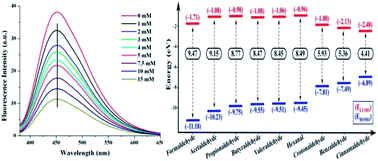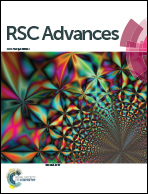Selective and sensitive detection of cinnamaldehyde by nitrogen and sulphur co-doped carbon dots: a detailed systematic study†
Abstract
Nitrogen and sulfur co-doped carbon dots (NSCDs) synthesized through one-pot microwave-assisted pyrolysis of tartaric acid and thioacetamide have been used as a fluorescent probe for the sensitive and selective detection of clinically important organic aldehyde cinnamaldehyde. The as-prepared NSCDs displayed blue fluorescence (∼12% quantum yield), excellent aqueous solubility along with pH and excitation wavelength dependent emission behavior. In comparison to other aldehydes (formaldehyde, acetaldehyde, propionaldehyde, butyraldehyde, valeraldehyde, hexanal, crotonaldehyde and benzaldehyde) the fluorescence intensity of NSCDs was significantly quenched in the presence of cinnamaldehyde and the reduced intensity was linearly proportional to the concentration of cinnamaldehyde in the range of 0–15 mM with a detection limit of 99.0 μM. The fluorescence quenching of NSCDs was mainly attributed to the photo-excited electron transfer between NSCDs and aldehydes which was confirmed by measuring the life-time through time-resolved luminescence spectroscopy, energy levels of NSCDs through cyclic voltammetry (CV) and energy levels of aldehydes by density functional theory (DFT) based analyses. MTT assay of the NSCDs also proved their good biocompatibility and low toxicity towards human fibroblast cells thereby validating their suitability as a biologically relevant fluorescent probe for sensing cinnamaldehyde.



 Please wait while we load your content...
Please wait while we load your content...